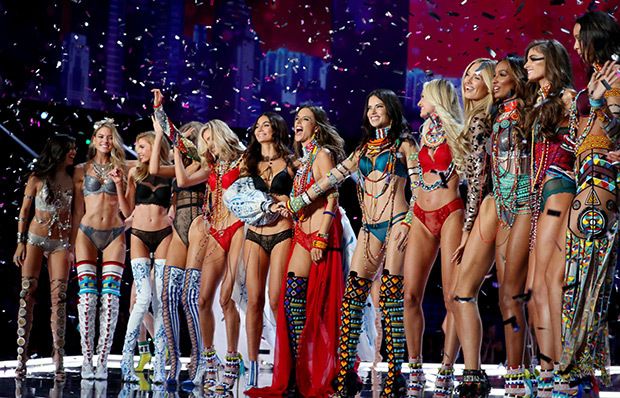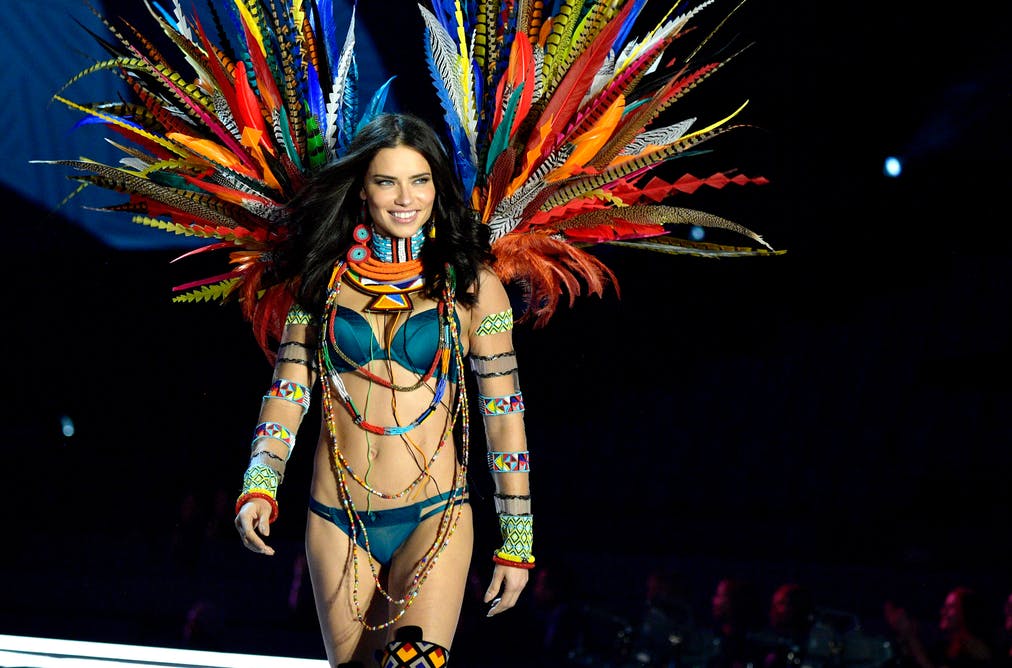
By Chelsey Luger — The fashion industry is in a vicious cycle. It uses and abuses Native imagery from cultures the world over. This promotes stereotypes and minimizes the voice of indigenous people. This perpetuates the idea that there are no intelligent, capable or modern indigenous people who could speak for or represent themselves and their communities.
The latest and most obvious example took place this week. The Victoria’s Secret fashion show—viewed by millions worldwide—gave us a massive dose of cultural appropriation with its “nomadic adventure”-themed 2017 runway motif. Models wore a hodgepodge of feathers, beads and prints that were supposedly inspired by “indigenous African culture,” and it was all kinds of messy.
This wasn’t a first offense. Victoria’s Secret apologized for a 2012 incident in which model Karlie Kloss walked the runway in a cheap interpretation of a northern Plains Native American headdress.
That the company has acknowledged its past mistakes makes this year’s incident all the more shocking. I had to wonder: Where does this “indigenous inspiration” come from?
I reached out to VS’ public relations department with two simple questions:
-
Were any indigenous African communities or individuals actually consulted about or hired to create this year’s designs?
-
If so, were they paid?
Unsurprisingly, I haven’t heard back.
In any case, it’s pretty obvious that, as for every other white-girl-in-a-headdress incident, Victoria’s Secret is not working with or hiring anyone who has an understanding of indigenous design and regalia to help conceptualize these shows.

Which leads to a larger question: Are any mainstream fashion companies seeking or recruiting designers, consultants or editors who are indigenous or who, at least, understand indigenous culture? I would wager not.
Native people are just as (if not more) tired of being angry about cultural appropriation in fashion as any other ethnic heritage. It’s high time those with influence and power in the fashion world begin to be proactive about the issue, and they can do that by keeping indigenous people on staff.
Hiring Native consultants and editors is not only in the best interest of indigenous communities, but also in the best interest of the companies and designers. It’s a matter of taste.
Keep in mind that even if all of this wasn’t offensive and inappropriate, it’s tacky. Anyone with an eye for authentic indigenous design can see that the cheap, rip-off versions of Native culture that the fashion world continues to tout are embarrassingly bad. Whether it’s high fashion or fast fashion or something in between, the companies and designers who are supposed to be the arbiters of taste and influencers of trends are getting it all wrong. They should know that in the Native world, they’re not cutting it. Anybody trying to sell these fake feathers and horrid patterns at an indigenous art market would be laughed away.
In any case, here’s some help. If you’re looking for indigenous artists, designers, fashion bloggers or anybody else to consult with on your next project, here’s a cheat sheet of resources:
-
She and Turquoise, a fashion blog edited by Shondina Lee.
-
Bethany Yellowtail, indigenous designer.
-
Beyond Buckskin, a blog and store run by Jessica Metcalfe.
-
Native Appropriations, edited by Adrienne Keene, an expert on Native appropriations.
-
Indigenous Goddess Gang, a whole slew of Native American women who are prepared to tell you like it is in any way, shape or form.
-
Native Fashion Now, a book that you should probably read.
-
Thosh Collins Photographer, an indigenous photographer.
There’s a start.
Now, for those of you who don’t see what the big deal is, or who can’t fathom removing your plastic headdress or mass-produced moccasins from your wardrobe, here are a few ideas for alternatives to indigenous cultural appropriation:
-
Wear a powdered wig (just like many of your ancestors).
-
Wear a bad suit (just like your noblemen and women of today).
-
Wear a cheap cowboy hat (just like Britney Spears).
-
Wear some Dockers (just like most white guys).
-
Wear a bikini or underwear along with rip-off versions of historical American or European war veteran outfits, so that you can show your veterans the same respect that ours are getting.
In all seriousness, remember that cultural appropriation is not just annoying, and it’s not just tacky. It’s harmful. Companies like Victoria’s Secret, and individuals who make the same mistake of headdress-and-bikini combos, are hypersexualizing Native women, putting us further at risk for objectification and dehumanization in a world where we are already at higher risk of sexual assault and rape than any other ethnicity.

As for the models, you’re not off the hook, either. People who have modeled for Victoria’s Secret, such as Kendall Jenner or Gigi Hadid, are massively influential. Part of their appeal with kids these days is that they use “wokeness” to improve their image. (Look at their Instagram pages for philanthropy updates.) They have the money and the time to hire people to make sure they’re not offending anybody. It’s a simple job—they should do it. Just as for the fashion companies, their public images would benefit. They can and should take steps to not embarrass themselves.
Finally, cultural appropriation in fashion plays a huge role in the continued dismissal of indigenous cultures as primitive, dismisses indigenous people as playthings, and perpetuates the idea that we are relics of the past. The truth is, we’re human, we’re here, and we are tired of being marginalized. We want our children to be taken seriously, we want our elders to be respected, and we want our headdresses to stay far away from your runways, Halloween parties and music festivals.
Chelsey Luger is a journalist originally from the Standing Rock Sioux Tribe and Turtle Mountain Band of Chippewa in North Dakota, currently based in Phoenix, Ariz. She reports on Native American and First Nations social justice issues, politics and pop culture. In March 2016, Luger broke the Dakota Access pipeline story for Indian Country Today Media Network and went on to cover the “No DAPL” movement throughout its duration. Luger is the co-founder and content editor of an indigenous health and wellness initiative: Well for Culture. Her work can be found in The Atlantic, The Huffington Post, Al Jazeera America, NowThis, Fusion and more.
Source: Truthdig







 The last Konyak headhunters of Nagaland
The last Konyak headhunters of Nagaland The Top Viral YouTube Videos of 2017
The Top Viral YouTube Videos of 2017 Meet R.N. Ravi, who is mediating peace with the Nagas
Meet R.N. Ravi, who is mediating peace with the Nagas An orbiting message of peace
An orbiting message of peace










Leave a Reply
Your email address will not be published. Required fields are marked (required)